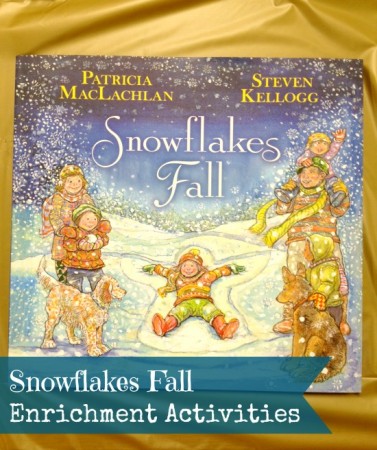The beautiful book Snowflakes Fall is the latest children’s book from author and Newbery Medalist Patricia MacLachlan. Partnering up with illustrator Steven Kellogg, the pair has created a book to teach children about hope using snowflakes to tell their story. Filled with beautiful illustrations of the wintry season, this book is a delightful winter time read. Take a look below at some enrichment activities that you can enjoy with your child to further help you understand and comprehend the text. They are all simple, fun, and frugal activities that are sure to help you enjoy the book further and soak in the message in a fun and hands on way.
Snowflakes Fall Enrichment Activities
1. Snowflake Investigation.
If weather permit, go outside and place a scoop of snow on a piece of tinfoil. Place the tinfoil in the freezer for several minutes prior to collecting your sample so the snow does not melt so quickly when you collect it. Using a magnifying glass, take a few minutes to look at the snowflakes and talk about what you see. What do they look like? What colors can be seen? What shapes? Take some time for children to verbalize and use adjectives to describe their findings.
2. No Two Are Alike.
When investigating the snowflakes, the children may have noticed that no two are alike. The same can go for people as well. Give each child a piece of paper that is the same size and color. Allow them to take scissors and snip out a snowflake into their paper. When done, compare the snowflakes. Are any two alike? Probably not! Hang your snowflakes and talk about how each child’s flake is unique, just like they are.
3. Snowflake Life Cycle.
In the story, the message is projected about how snowflakes turn to water, which turn to rain, which then waters the flowers. This is a great way to introduce the water cycle to children. Draw a picture eon a piece of poster board of the water cycle. This doesn’t need to be complex, just a picture of the rain cloud, snow falling, melting, evaporating, and then coming down as rain again. Children can draw arrows going from one step to the next in the cycle.
4. DIY Vocabulary Flip Book
Take a moment to walk through the book and write down any tricky words. These words will vary according to the age and needs of the child enjoying the book. On index cards, write down the words and a picture next to the word to define it. Staple the cards together and create a vocabulary flip book to enjoy later!
5. Make your own frost.
Why not try creating your own ice crystals indoors? Try pouring water into a variety of containers and place them in the freezer. Check on them often and make note of the changes taking place. Look for the small crystals, and investigate the process under a magnifying glass if possible. If you wish, you can even add a drop or two of blue food coloring to the water to create some super wintry effects.
6. Making predictions.
In the story, the snow falls on sleeping gardens and trees. Ask children to imagine what is happening under that snow. What is the garden or tree doing? How does it feel? Although they can’t see the particular object, allow them to make predictions about what might be taking place.
7. Making connections.
In the story, dogs and children alike enjoy the falling snow. Ask children to share a time that they enjoyed the snow. Where were they? Who were they with? What did they do? Allow plenty of time for children to make connections to the text and talk about how it relates to them.
A few other activities you can enjoy in addition to these can be building a snowman together, catching snowflakes on your tongue, make your own snowflakes by painting water colors onto coffee filters, or head to your local library to check out more books on snow and snowflakes. You will be surprised at how many are out there!
This winter, help pass the time by enjoying the book Snowflakes Fall. It is a sweet read with a beautiful message you are sure to enjoy!


Leave a Reply